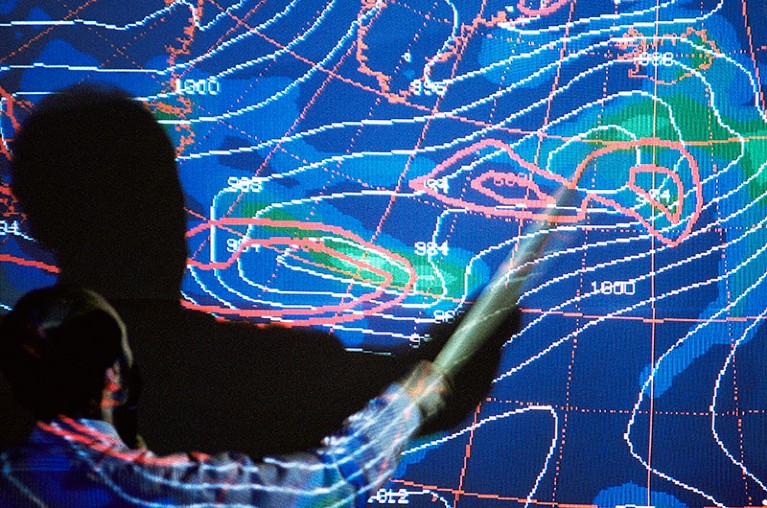Conventional weather forecasts are the result of intensive processing of data from weather stations around the world.Credit: Carlos Munoz Yague/Look At Science/Science Photo Library
Artificial-intelligence (AI) firm Google DeepMind has turned its hand to the intensive science of weather forecasting — and developed a machine-learning model that outperforms the best conventional tools as well as other AI approaches at the task.
The model, called GraphCast, can run from a desktop computer and makes more accurate predictions than conventional models in minutes rather than hours.
“GraphCast currently is leading the race amongst the AI models,” says computer scientist Aditya Grover at University of California, Los Angeles/ The model is described1 in Science on 14 November.
Predicting the weather is a complex and energy-intensive task. The standard approach called numerical weather prediction (NWP), a type of ‘physical model’. The tools crunch weather data from buoys, satellites and weather stations worldwide using supercomputers. These calculations accurately map out how heat, air and water vapour move through the atmosphere, but they are expensive and energy-intensive to run.
Forecast revolution
To reduce the financial and energy cost of forecasting, several technology companies have developed machine-learning models that rapidly predict the future state of global weather from past and current weather data. Among them are DeepMind, computer chip-maker Nvidia and Chinese tech company Huawei, alongside a slew of start-ups such as Atmo based in Berkeley, California. Of these, Huawei’s Pangu-weather model is the strongest rival to the gold-standard NWP system based at the European Centre for Medium-Range Weather Forecasts (ECMWF), which provides world-leading weather predictions up to 15 days in advance.
Machine learning is spurring a revolution in weather forecasting, says Matthew Chantry at the European Centre for Medium-Range Weather Forecasts in Reading, UK. AI models run 1,000 to 10,000 times faster than conventional NWP models, leaving more time for interpreting and communicating predictions, says data-visualization researcher Jacob Radford, at the Cooperative Institute for Research in the Atmosphere in Colorado.
DeepMind, Google’s AI company in London, newly released model GraphCast outperforms conventional and AI-based approaches at most global weather-forecasting tasks. Researchers first trained the model using estimates of past global weather made from 1979 to 2017 by physical models. This allowed GraphCast to learn links between weather variables such as air pressure, wind, temperature and humidity.
The trained model uses the ‘current’ state of global weather and weather estimates from 6 hours earlier to predict the weather 6 hours ahead. Earlier predictions are fed back into the model, enabling it to make estimates further into the future. DeepMind researchers found that GraphCast could use global weather estimates from 2018 to make forecasts up to 10 days ahead in less than a minute, and the predictions were more accurate than the ECMWF’s High RESolution forecasting system (HRES) — one version of its NWP — which takes hours to forecast.
Severe weather
“In the troposphere, which is the part of the atmosphere closest to the surface that affects us all the most, GraphCast outperforms HRES on more than 99% of the 12,00 measurements that we’ve done,” says computer scientist Remi Lam at DeepMind in London. Across all levels of the atmosphere, the model outperformed HRES on 90% of weather predictions.
GraphCast predicted the state of 5 weather variables close to the Earth’s surface, such as the air temperature 2-metres above the ground, and 6 atmospheric variables, such as wind speed, further from the Earth’s surface.
It also proved useful in predicting severe weather events, such as the paths taken by tropical cyclones, and extreme heat and cold episodes, says Chantry.
When they compared the forecasting ability of GraphCast with Pangu-weather, the DeepMind researchers found that their model beat 99% of weather predictions that had been described in a previous Huawei study.
Chantry notes that although Graphcast’s performance was superior to other models in this study, based on its evaluation by certain metrics, future assessments of its performance using other metrics could lead to slightly different results.
Training data
Rather than entirely replacing conventional approaches, machine-learning models, which are still in their experimental stage, could boost particular types of weather predictions that standard approaches aren’t good at, says Chantry — such as forecasting rainfall that will hit the ground within a few hours.
“And standard physical models are still needed to provide the estimates of global weather that are initially used to train machine-learning models,” says Chantry. “I anticipate it will be another two to five years before people can use forecasting from machine learning approaches to make decisions in the real-world,” he adds.
In the meantime, problems with machine-learning approaches must be ironed out. Unlike NWP models, researchers cannot fully understand how AIs such as GraphCast work because the decision-making processes happen in AI’s ‘black box’, says Grover. “This calls into question their reliability,” she says.
AI models also run the risk of amplifying biases in their training data and require a lot of energy for training, although they consume less energy than NWP models, says Grover.
